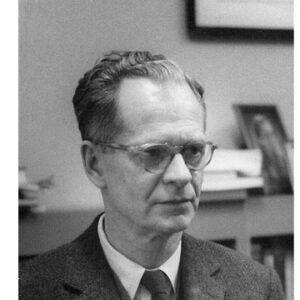Burrhus Frederic “B.F.” Skinner was a pioneer in the field of behaviorism as a psychologist and social philosophy. He established a distinct school of psychology called as “radical behaviorism,” which was distinct from the other schools. He felt that living creatures had a tendency to repeat behaviors that they feel produce positive effects. The principle of reinforcement was his name for it. He was a bright, creative, and independent thinker who, due to the nature of his work, was frequently surrounded by controversy. He believed that free will was a figment of the imagination and strongly rejected that humans had any freedom or dignity. He was also an inventor, and he is credited with developing the operant conditioning chamber, which is used to research behavior conditioning. He created the air crib, which is a temperature and humidity-controlled crib for baby care. This was his most divisive innovation, and he was widely chastised for inflicting brutality on tiny children. He wrote more than 20 books and 180 articles, the most well-known of which are ‘Walden Two’ and ‘Beyond Freedom and Dignity.’ He worked as a professor in numerous universities throughout his life and had a significant impact on the subject of education.
Childhood and Adolescence
Skinner was born in Pennsylvania to William Skinner, a lawyer, and Grace Skinner, his wife. He had a happy upbringing and enjoyed inventing new things. At a young age, he became an atheist.
He aspired to be a writer and enrolled at Hamilton College in New York to pursue his dream. However, because of his academic approach, he was unable to fit in in college. In 1926, he earned his B.A. in English literature.
He studied at Harvard University and graduated with a master’s degree in 1930.
Following his graduation, he attempted to write a novel but quickly became disillusioned with his literary abilities. He was inspired to study psychology after an accidental encounter with John B. Watson’s ‘Behaviorism.’
The career of BF Skinner
He graduated from Harvard University with a Ph.D. in 1931 and worked as a researcher until 1936.
He started working on the operant conditioning chamber while still at Harvard. It’s also known as the Skinner box, and it’s a tool for studying operant and classical conditioning in animals.
He became an instructor at the University of Minnesota after leaving Harvard in 1936. In 1937, he was promoted to Assistant Professor, then in 1939, to Associate Professor. He served in this capacity until 1945.
In 1945, he was hired as a professor at Indiana University, where he also served as the chair of the psychology department. After three years of service, he decided to leave.
In 1948, he was hired as a tenured professor at Harvard University, where he remained for the rest of his career.
He established the ‘radical behaviorism’ school of psychology, which he named after himself. His psychology study is founded on operant conditioning, and he believes that living beings lack free will and will repeat behavior that benefits them.
He created the teaching machine, a technology that makes learning easier for a variety of students. To inspire pupils, the machine might provide a curriculum of pre-programmed teaching, ask them questions, and reward them for each correct answer.
In 1948, he published a novel called ‘Walden Two,’ a utopian novel. Skinner’s book was divisive because it disregarded the concepts of free choice, spirit, and soul. He claims that genetic and environmental factors, not free will, influence human behavior.
He released his book ‘Verbal Behavior’ in 1957, in which he examined human behavior using language, linguistics, and speech. It was a purely theoretical work with the minimal experimental investigation to back it up.
‘Beyond Freedom and Dignity,’ his most famous work, was published in 1971. He supported his own science philosophy and what he dubbed “culture engineering” in this work. The book went on to become a best-seller in the New York Times.
Skinner’s Major Projects
He devised the operant conditioning chamber, which aids in the study of animal behavior conditioning by teaching them to perform specific actions in response to specific stimuli. These chambers are used to investigate animal behavior and psychology in a variety of research domains.
Radical behaviorism, his school of psychology, is used in a variety of disciplines in modern society, including management, therapeutic practice, animal training, and education. His theories can also assist in the development of therapy for autistic youngsters.
Achievements & Awards
In 1971, the American Psychological Foundation awarded him a gold medal.
In 1990, the American Psychology Association honored him with the Lifetime Achievement Award for his outstanding contributions to the field of psychology.
Personal History and Legacy
In 1936, he married Yvonne Blue. Julie and Deborah were the couple’s two daughters. Julie, his daughter, is a writer and educator.
With his backing, the B.F. Skinner Foundation was launched in 1988 to promote the research he founded. Julie, his daughter, is the foundation’s president.
In 1989, he was diagnosed with leukemia and died of it in 1990.
Estimated Net Worth
BF is one of the wealthiest psychologists and one of the most well-known psychologists. BF Skinner’s net worth is estimated to be around $2 million, according to Wikipedia, Forbes, and Business Insider.
Trivia
Noam Chomsky, a philosopher, and cognitive scientist, was his harshest critic.
His favorite experimental animal was the pigeon.


